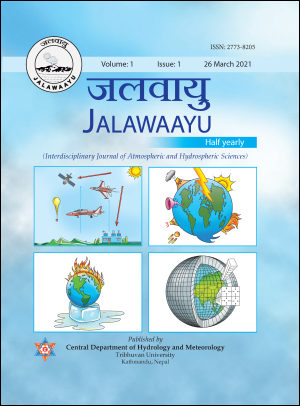Rainfall-runoff simulation of Bagmati River Basin, Nepal
DOI:
https://doi.org/10.3126/jalawaayu.v1i1.36450Keywords:
Bagmati River, Hydrological modeling, Rainfall, Runoff, Flood forecastingAbstract
Runoff simulation is a complex problem in mountain catchments due to high rainfall variability and rugged topography. In the lower parts of Nepal, river flooding is a serious disaster problem in July and August; sometimes it also occurs in September. In this context, Hydro-Informatic Modeling System (HIMS) was used for daily and monthly runoff simulation from the set of daily hydro-meteorological data (Maximum and minimum temperature, rainfall, and discharge) in the time series 1980 to 1989, 1990 to 1999, and 2000 to 2009, respectively. The model performed well for the monthly runoff simulation, whereas the efficiency coefficient and relative coefficient both were found a very good correlation between observed and simulated hydrographs, which varied between 0.883 to 0.940 and 0.889 to 0.945, respectively. However, the efficiency coefficient and relative coefficient both were found a very poor correlation between observed and simulated hydrographs for the daily runoff simulation, which averaged 0.342 and 0.348, respectively. The daily simulation result also might have been improved, if more number of uniformly distributed meteorological station data is available.
Downloads
Downloads
Published
How to Cite
Issue
Section
License
Copyright © of the articles is held by the authors.

